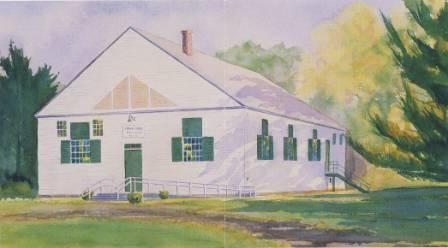Plainfield Town Hall

The frame of the Plainfield Town Hall was built in 1798 on the Center of Town Road, approximately three miles from its present location. Religious services and annual town meetings were held there until 1810 when it was moved or dismantled and rebuilt on Route 12-A just south of the Plainfield Cemetery, approximately one-half mile from its present location. In 1844, the town voted to raise $60 for the purchase of the structure from the proprietors. The meeting house was no longer needed for church services. The building was moved to it’s present site in Plainfield Village in 1846 and rebuilt at a cost of $800. At that time the tall windows were put in, the shutters added, and the interior plastered. It served as a location for annual town meetings (in alternate years at the Meriden Town Hall) until 1973 when the gymnasium was completed at the new school.
In 1916, the building known earlier as the Town House was equipped with complete facilities for theatrical productions, including stage, curtain, lighting and a stage set designed by Maxfield Parrish. This was all contributed by William Howard Hart, a distinguished New York stage designer and artist who summered in Plainfield for many years during the Cornish Art Colony era. Throughout New England, Plainfield had the reputation of having “the most beautiful stage north of Boston”1
Over the years, a variety of town activities have taken place in the Town Hall including plays, dances, movies, bingo, fund raisers, historical society meetings, basketball games, variety nights, library programs, rummage sales, concerts, art shows, bicentennial celebrations, town meetings and even rifle practice.
The Plainfield Town Hall was placed on the National Register of Historic Places in 1985. It is also included on the National List of Historic Theater Buildings. The Town Hall’s renovations were completed in 1995.
Painting of Town Hall by Steve Plummer.
1.“Choice White Pines and Good Land: A History of Plainfield and Meriden, NH.”
Contact Info
Plainfield Historical Society
1063 Route12A
Mailing: PO Box 107
Plainfield NH 03781
Phone: 603-298-8834
Email: info@phsnh.org


